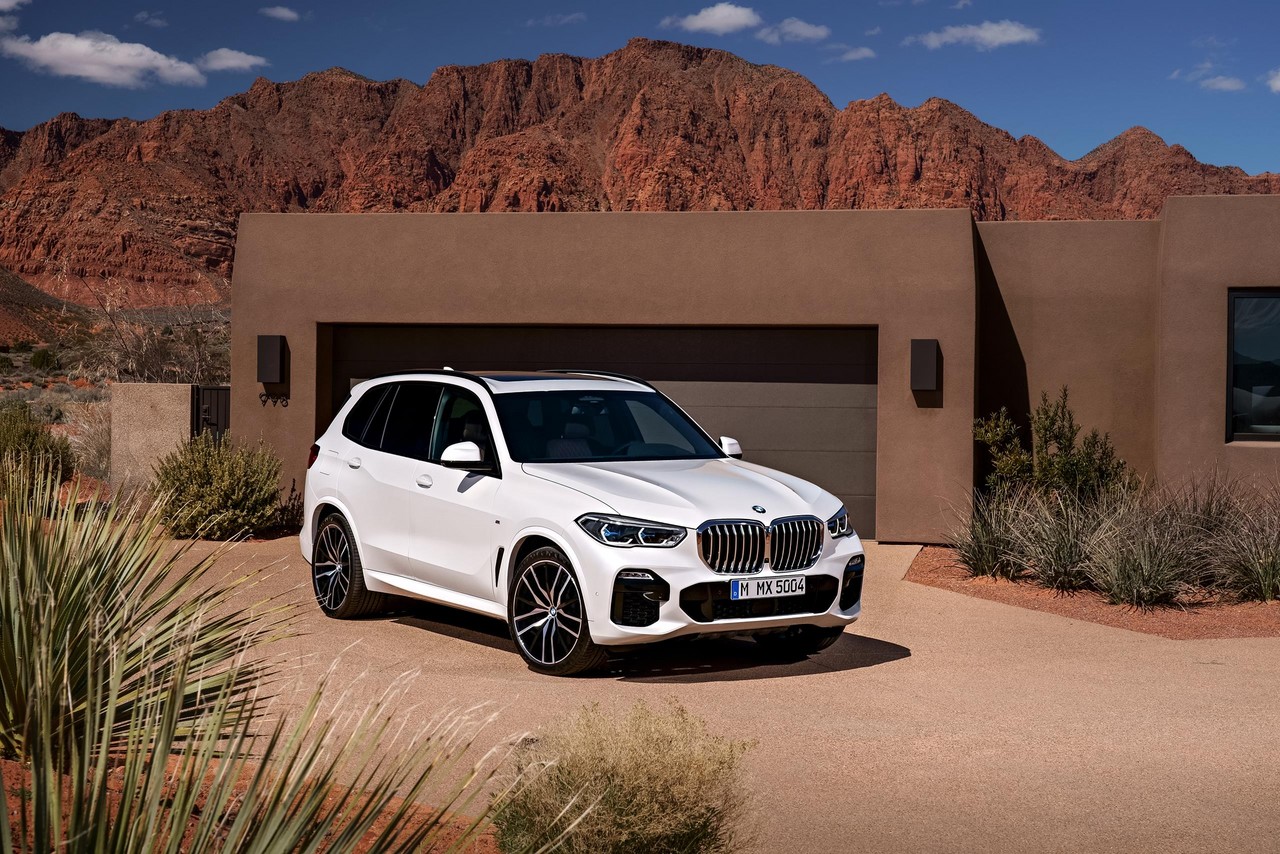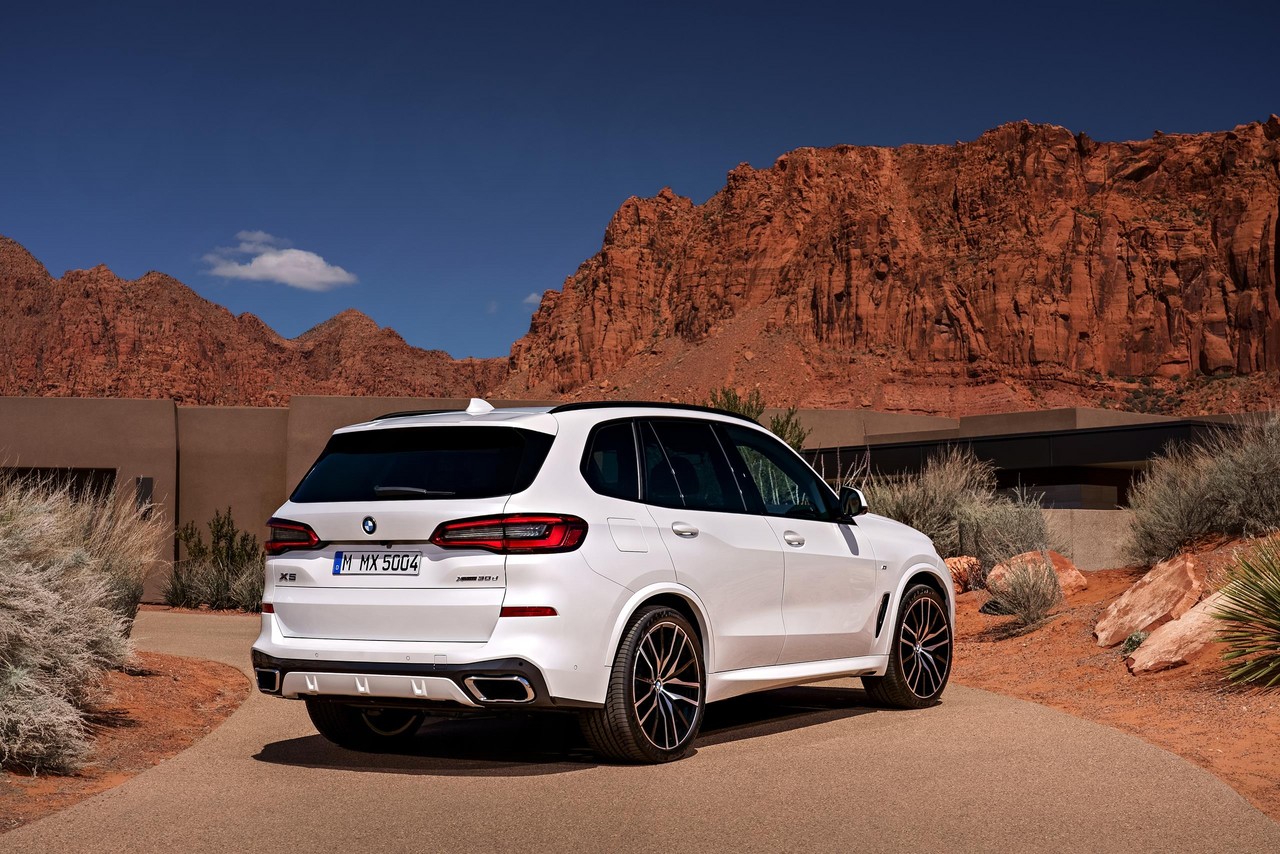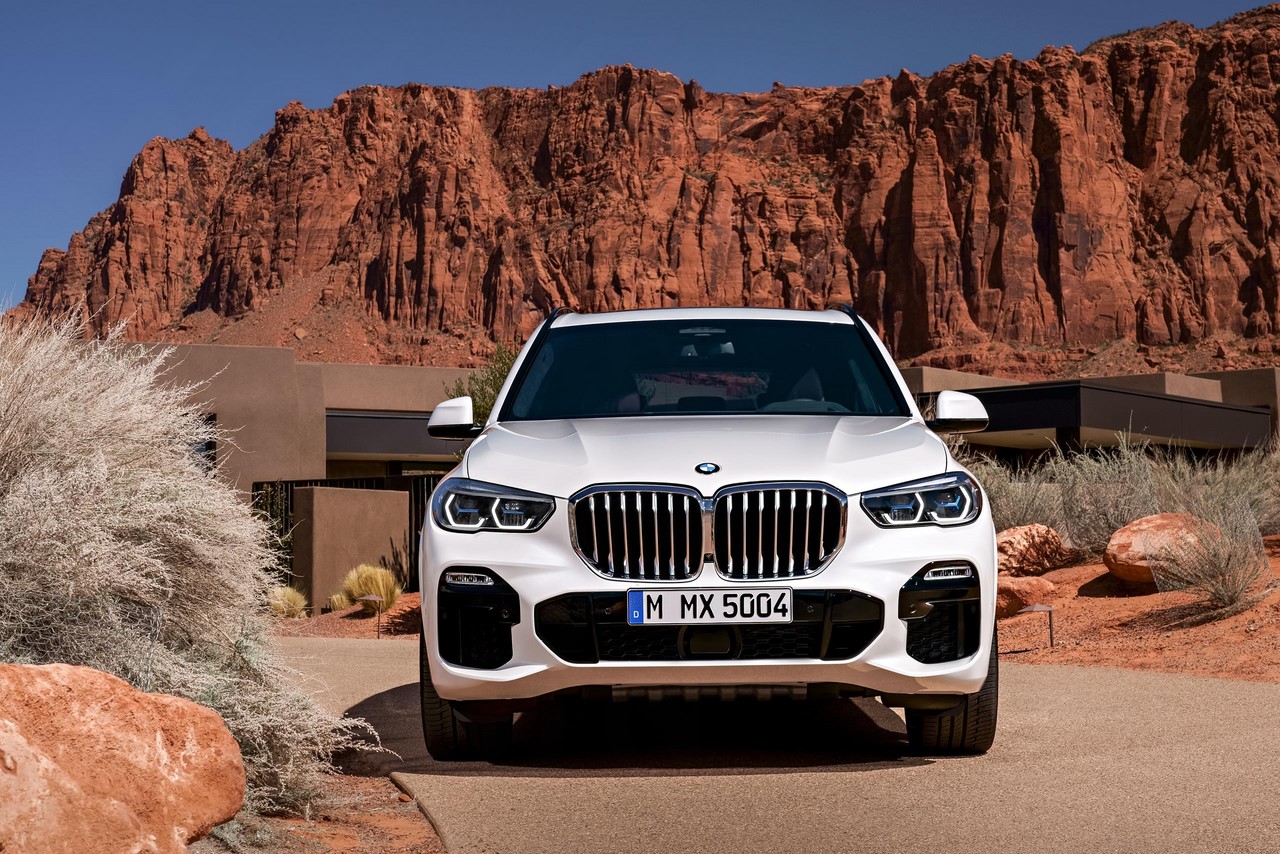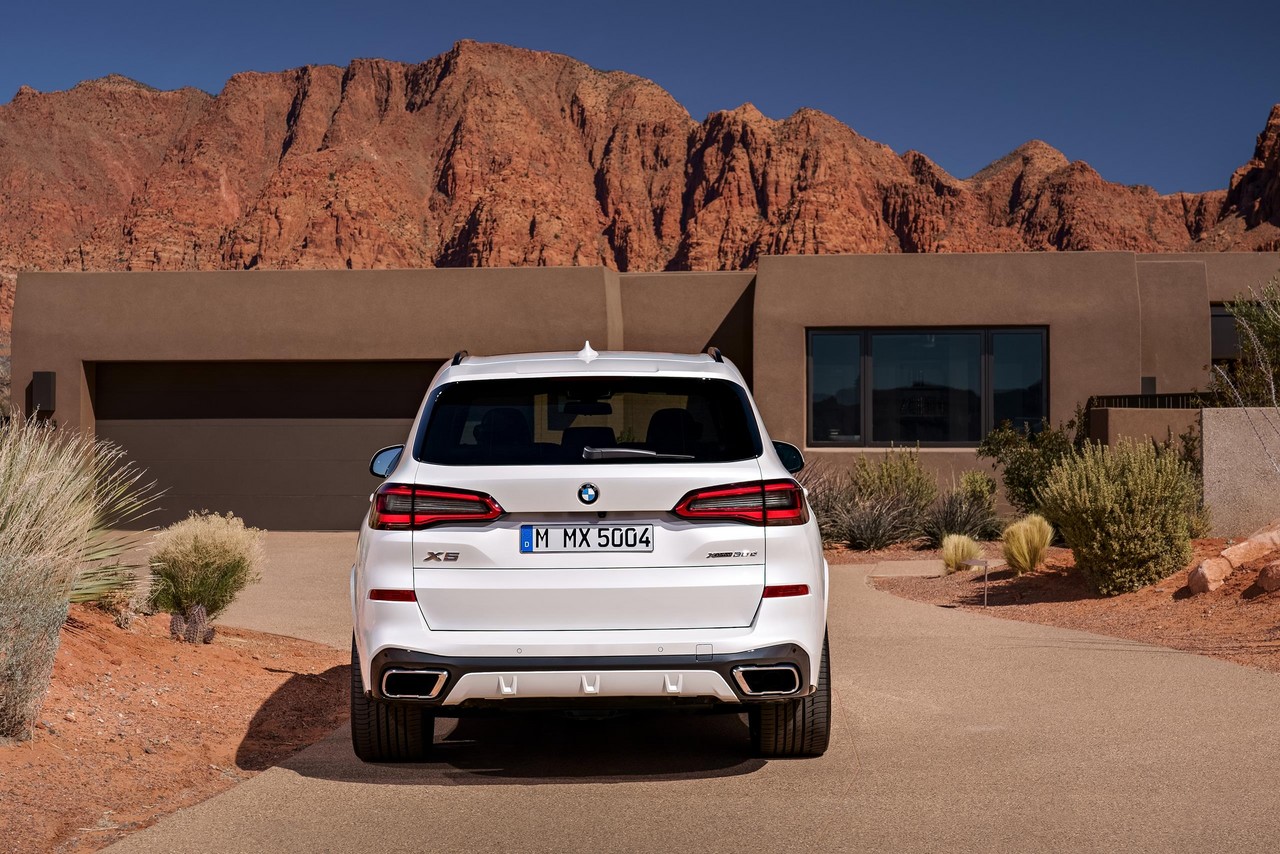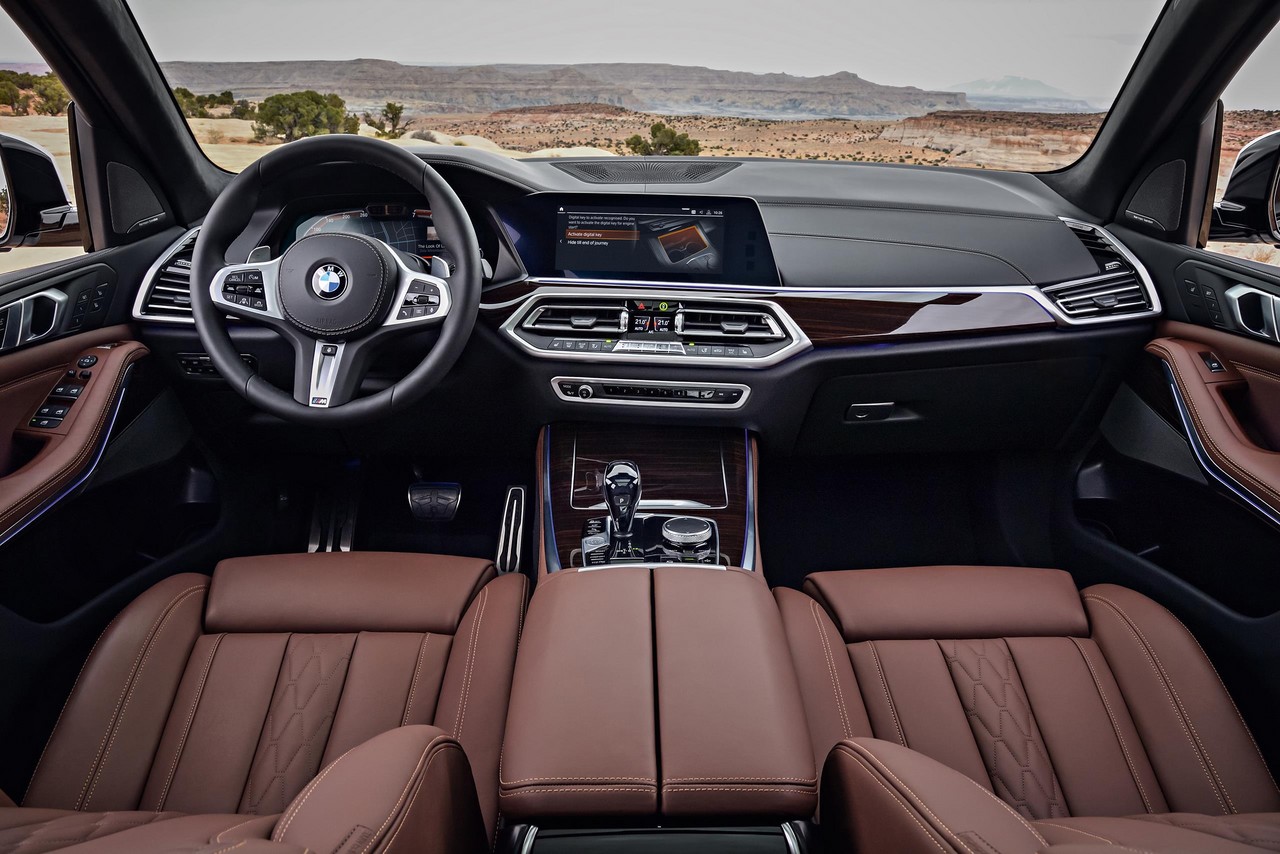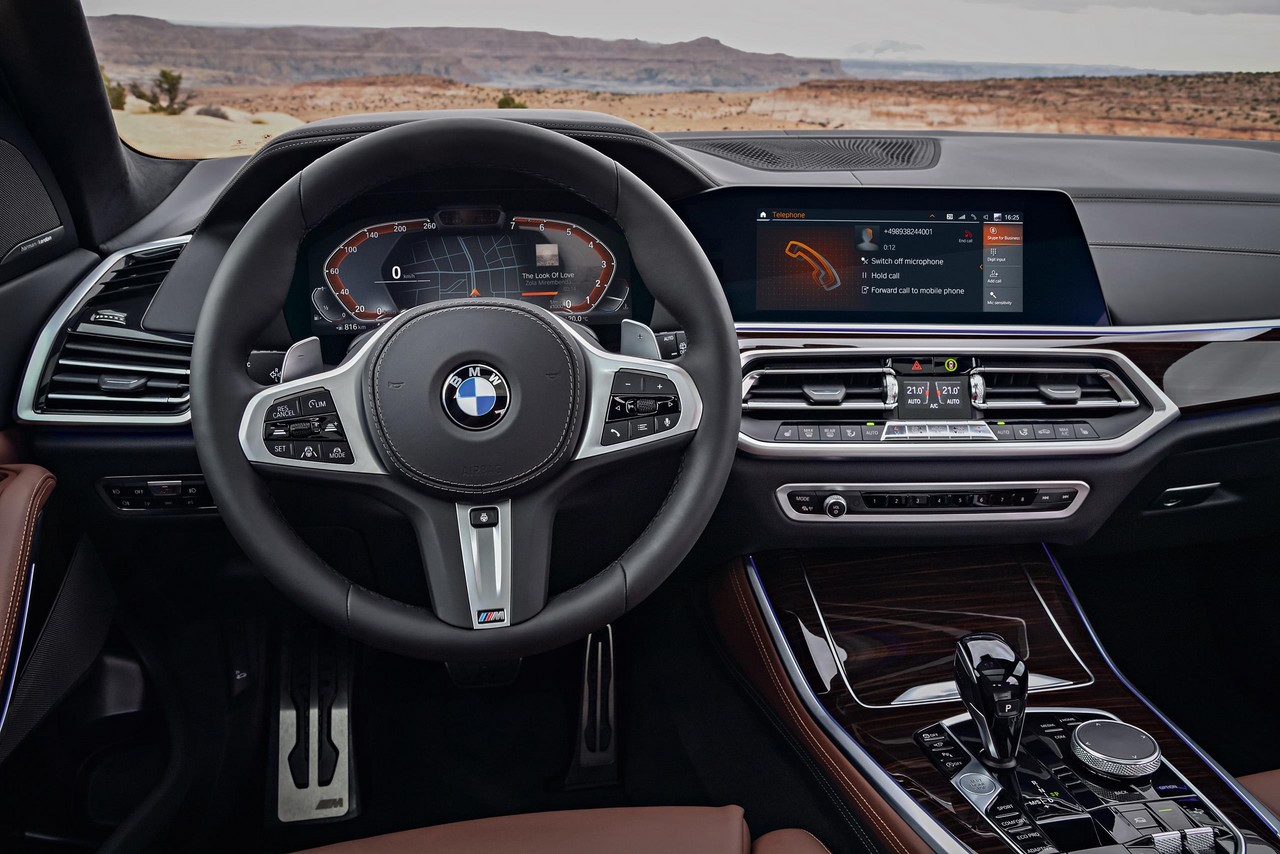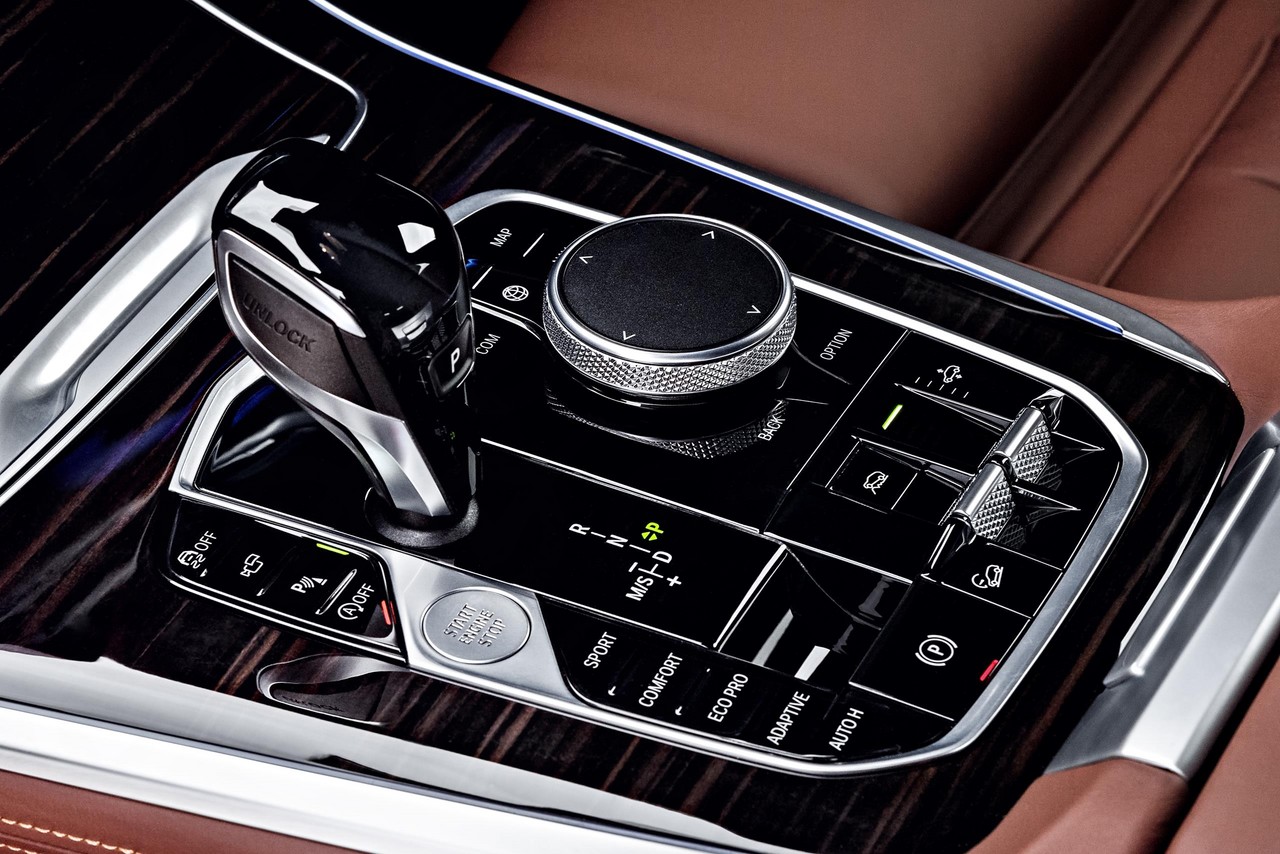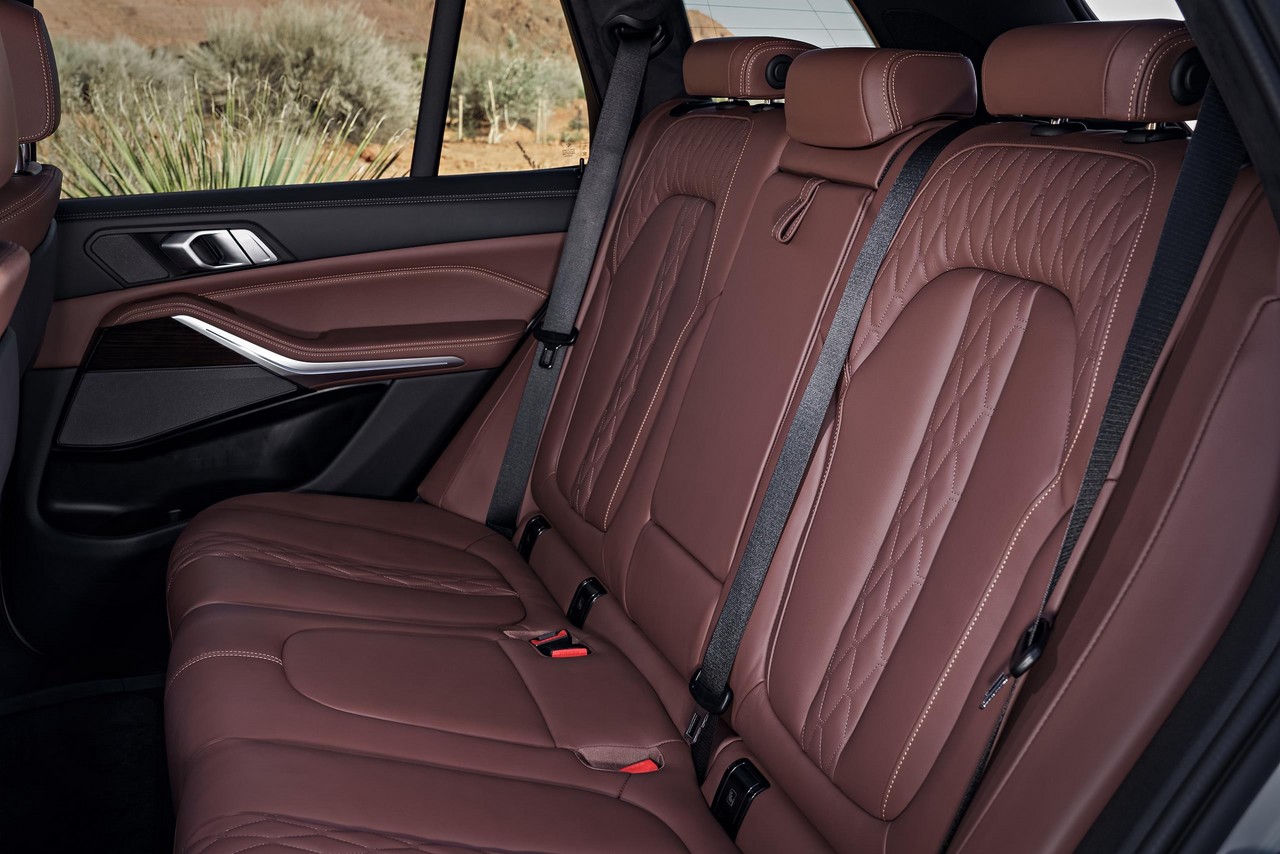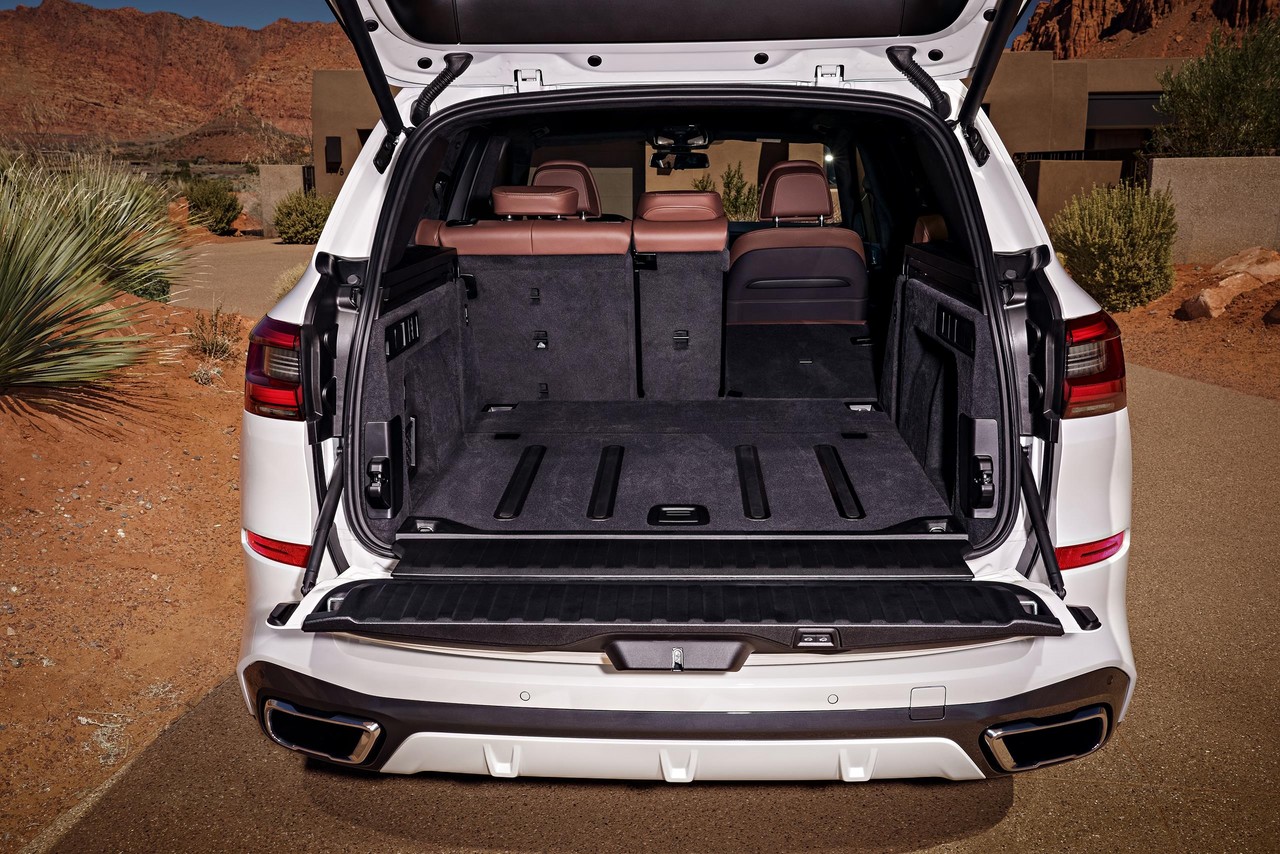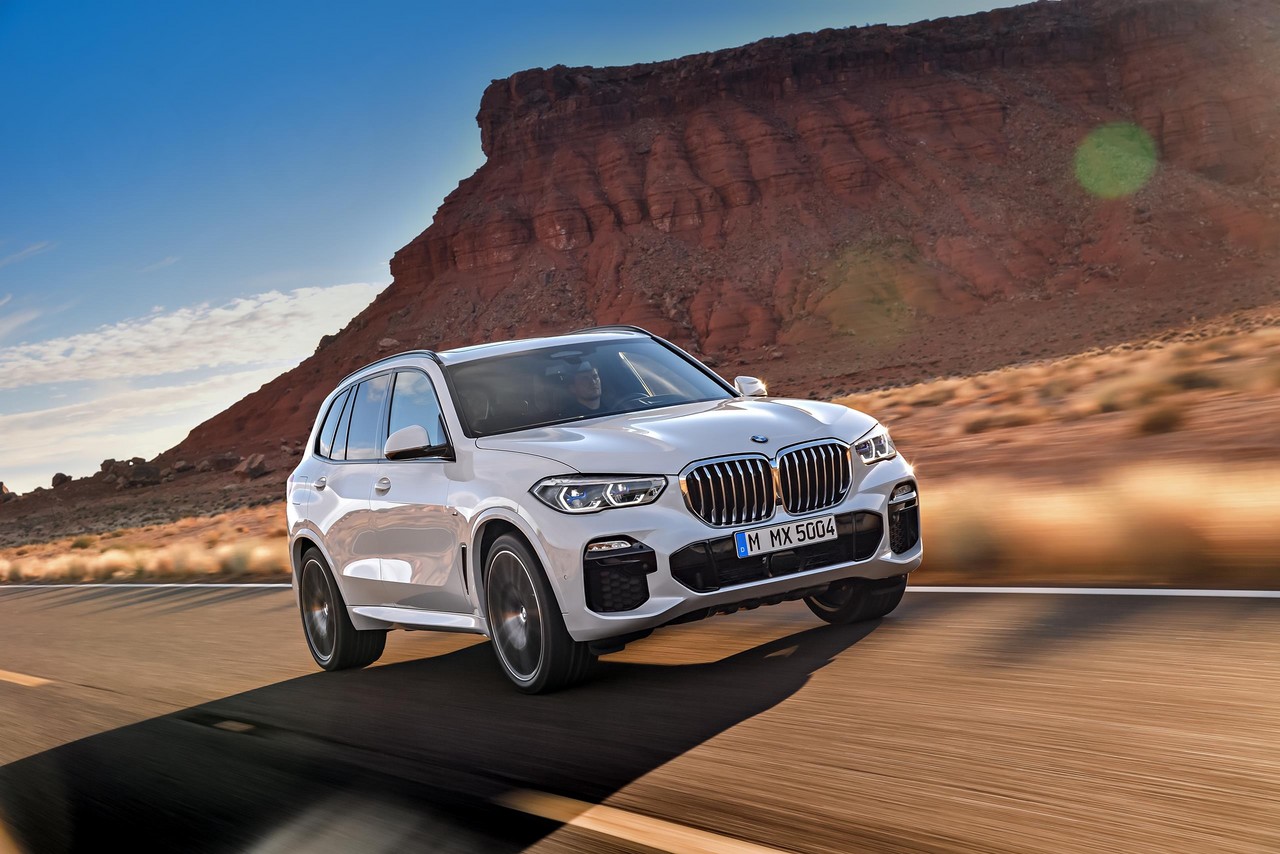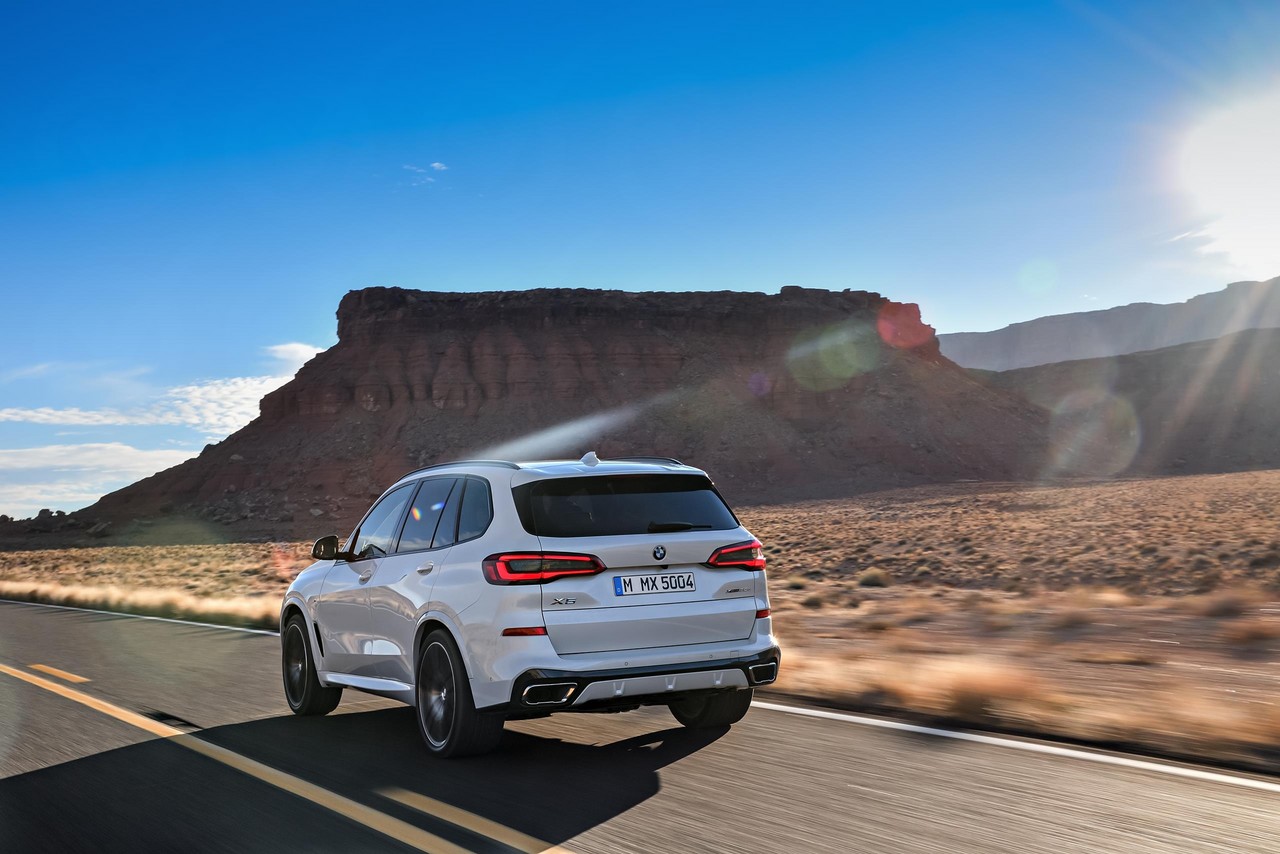
- Powerful and refined engines
- High standard of interior fit and finish
- Active safety technologies fitted as standard
- Impressive handling, but…
- … run-flat tyres contribute to harsh ride, especially for M50d and M50i
- Heavy (and wide)
- Steering lacks feel
- Second row leg room
- Digital instruments are hard to read and lack configurability
- ISOFIX child seat anchorages only for outer seats
Overview
Released in Australia in November 2018, the BMW G05 X5 was a large ‘Sports Activity Vehicle’ (SAV). Manufactured at BMW’s Spartanburg plant in South Carolina, the all-wheel drive BMW G05 X5 range for Australia initially consisted of the xDrive30d and M50d variants (see table below). While the BMW G05 X5 had five seats as standard, a third row of seats was available as an option.
To reduce fuel consumption, all variants had:
- An ‘Auto Start Stop’ function which could shut down the engine when the vehicle was stationary in traffic;
- An ‘Eco Pro’ mode which adjusted engine management, throttle response and transmission behaviour to minimise fuel consumption. Eco Pro also included a coasting function that could disengage the engine from the powertrain when the driver eased off the accelerator (to prevent engine braking); and,
- ‘Brake Energy Regeneration’ which regulated alternator output to recharge the battery when the vehicle was coasting or braking.
To reduce emissions, the xDrive40i and xDrive50i had a particulate filter, while the xDrive30d and M50d have a particulate filter, oxidation catalyst, NOx adsorption catalyst and selective catalytic reduction (SCR) which used AdBlue injection.
Unusually, the 3.0-litre diesel engine for the BMW M50d had two low-pressure turbochargers and two high-pressure turbochargers (the latter with variable inlet geometry). In normal driving situations, both low-pressure turbochargers and one of the two high-pressure turbochargers were active. The second high-pressure turbocharger, however, only engaged once engine speed exceeded 2500 rpm. Under hard acceleration from idle, however, flaps were actuated so that the two low-pressure turbochargers were bypassed.
| Engine | Trans. | Peak power | Peak torque | |
|---|---|---|---|---|
| xDrive30d | 2993 cc B57D30O0 turbo diesel I4 | 8sp auto (ZF 8HP75) |
195 kW at 4000 rpm | 620 Nm at 2000-2500 rpm |
| M50d | 2993 cc B57D30 quad turbo diesel I6 (two low-pressure and two high-pressure turbos) |
8sp auto (ZF 8HP75) |
294 kW at 4400 rpm | 760 Nm at 2000-3000 rpm |
| xDrive40i | 2998 cc B58B30M0 twin-scroll turbo petrol I6 | 8sp auto (ZF 8HP75) |
250 kW at 5500-6500 rpm | 450 Nm at 1500-2500 rpm |
| xDrive50i | 4395 cc N63B44TU biturbo petrol V8 (two twin-scroll turbos) |
8sp auto (ZF 8HP75) |
340 kW at 5250-6000 rpm | 650 Nm at 1500-4750 rpm |
xDrive all-wheel drive system
AustralianCar.Reviews understands that the all-wheel drive system for the BMW G05 X5 had an electronically controlled, multi-plate clutch in the transfer case. The ‘xDrive’ all-wheel drive system was able to vary drive torque between the front and rear wheels and, where all-wheel drive was not required, all the engine’s torque could be directed to the rear wheels. Furthermore, when the driver adopted ‘a particularly dynamic style at the wheel’, the xDrive system provided a rear-biased torque distribution.
For the ‘M Sport’ equipment line and the Off-road package, the BMW G05 X5 was equipped with an electronically controlled rear differential lock. Controlled by the electronic stability control system (BMW’s ‘DSC’), the locking function for the rear differential could prevent a wheel from spinning in low-traction situations, thereby improving traction and power transmission when driving on loose ground or surfaces with variable grip levels. This locking effect was achieved by an electric motor and allowed up to 1500 Nm of drive torque to be redirected from the faster-turning (i.e. low traction) wheel to the slower-turning wheel.
Dimensions and body
Compared to the BMW F15 X5 which it replaced, the G05 X5 was 36 mm longer (at 4922 mm), 66 mm wider (2004 mm), 19 mm taller (1745 mm) and had a 42 mm longer wheelbase (2975 mm). Furthermore, ground clearance was 214 mm and the G05 X5 had a drag co-efficient of 0.31 Cd for the X5 xDrive30d.
While the BMW G05 X5 had five seats as standard, an optional third row of seats – with optional fore/aft power adjustment – was available as an option. A control panel in the boot could be used to slide the second-row seats forwards or backwards, and fold down the backrests of the second and third rows (where fitted). The second-row seats could also be tilted forward electrically for easier ingress and egress. Boot capacity for the G05 X5 was 645 litres, though this increased to 1860 litres when the 40:20:40 split rear seat backrest was folded down and luggage was filled to the roofline. For ease of loading, the BMW X5 had a two-section tailgate and the optional ‘Comfort Access’ function enabled both sections to be opened or closed automatically and hands-free.
Suspension
The BMW G05 X5 had aluminium double wishbone front suspension and a steel five-link rear axle. As standard, the G05 X5 was equipped with BMW’s ‘Dynamic Damper Control’ which consisted of electronically controlled dampers that enabled the driver to select from two performance maps via the ‘Driving Experience Control’ switch. For greater ‘agility and steering precision’, the BMW X5 M50d has model-specific kinematics and elastokinematics for the wheel suspension, and unique spring and damper tuning.
Fitted as standard for the BMW X5 M50d, BMW’s ‘Adaptive M suspension Professional’ included active roll stabilisation and Integral Active steering (the latter is explained under ‘Steering’, below). For active roll stabilisation, the anti-roll bars at the front and rear axles were split and each one was connected in the centre by an electric swivel motor. Actuation of the swivel motor caused the two links on the anti-roll bar to twist and counteract forces causing the roll tendency.
As an option, the BMW G05 X5 could be specified with air suspension and automatic self-levelling. For this system, the suspension’s air supply was controlled individually for each wheel using an electrically-driven compressor with a pressure reservoir. When ‘Sport’ mode was engaged or vehicle speed exceeded 138 km/h, ride height was lowered by 20 mm. A button in the luggage compartment could also engage a ‘loading mode’ that lowered the vehicle a further 20 mm. Ground clearance, however, could also be raised in two stages to a maximum of 40 mm above the standard setting (for a maximum clearance of 254 mm).
All BMW G05 X5 variants other than the X5 M50d could be specified with an ‘Off-Road package’ which included front and rear underguard elements, two-axle air suspension and an electronically controlled rear differential lock. The Off-Road package also added unique graphics to the instrument cluster and Control Display, and an extra button on the centre console for selecting the four driving modes.
Steering
The BMW G05 X5 had rack-and-pinion steering with electric power assistance; the G05 X5’s turning circle was 12.5 metres, while the overall steering ratio was 18.7:1. Fitted as standard for the BMW X5 M50d, BMW’s ‘Integral Active Steering’ provided rear wheel steering. At parking speeds, the rear wheels would turn in the opposite direction to the front wheels to reduce the turning radius. At higher speeds, however, the rear wheels would turn in the same direction as the front wheels for greater stability.
Safety equipment
Standard safety equipment for the BMW G05 X5 included dual front airbags, front seat-mounted side airbags, full-length curtain airbags (i.e. for front and second row seats), ABS, electronic brake force distribution, electronic stability control, traction control and front seatbelts with pre-tensioners and load limiters.
Australian-delivered BMW G05 X5 vehicles were equipped with the following safety technologies as standard:
- Forward Collision Warning and Pedestrian Warning with City Braking: operating at speeds between 10 and 60 km/h, the system would warn the driver if a pedestrian or stationary vehicle was detected in the BMW X5’s path. If the driver failed to react, the system would automatically apply the brakes to prevent or minimise the severity of a collision;
- Active Cruise Control with Stop&Go function: at speeds from 30 km/h to 210 km/h, Active Cruise Control could maintain a speed-dependent distance from the vehicle ahead. With the Stop&Go function, the brakes could be applied to bring the G05 X5 to rest; once the traffic ahead began to accelerate, the BMW X5 would automatically accelerate if the vehicle had been stationary for up to 30 seconds;
- Lane Keeping Assistant: helped the driver pre-empt hazards by automatically applying corrective steering in three types of situation: 1) if the system detected that the vehicle was about to leave the road, 2) if the driver was about to change lanes and had not seen a vehicle in the next lane or 3) if danger was detected due to an approaching vehicle (see ‘Side Collision Warning’, below). Furthermore, holding the direction indicator could initiate a lane change;
- Lane Departure Warning: active at speeds above 72 km/h, the driver would be alerted by steering wheel vibrations if the vehicle deviated from its lane without prior activation of the indicators and active steering inputs would bring the vehicle back to its intended lane;
- Lane Change Warning: active at speeds above 10 km/h, Lane Change Warning monitored the zones to each side of the vehicle. If the driver activated the indicators to change lanes, the system would check these zones and – if occupied – warn the driver via steering wheel vibrations and flashing a symbol in the respective door mirror;
- Side Collision Warning: operating at speeds between 30 km/h and 210 km/h, Side Collision Warning would alert the driver via a visual signal or steering wheel vibration if another vehicle was ‘encroaching’ from the side. If the system detected sufficient room on the other side of the vehicle, it would correctively steer the vehicle in this direction to avoid the danger. The corrective steering assistance, however, could be over-ridden by the driver at any time;
- Steering and lane control assistant: operating at speeds up to 210 km/h, the steering and lane control assistant provided ‘comfort-enhancing steering interventions’ to keep the vehicle in its current lane (even where road markings are unclear). In stop-start traffic, the system also used the preceding vehicle as a reference point;
- Evasion aid: operating at speeds up to 160 km/h, the evasion aid helped avoid collisions with vehicles or pedestrians that suddenly appeared in the driver’s path by providing steering inputs that assisted the driver to direct the vehicle into a clear adjacent lane;
- Crossing traffic warning front: used radar sensors to check for approaching traffic at junctions with poor or impeded visibility;
- Crossing-traffic warning rear: when reversing out of a parking space, ‘Crossing-traffic warning rear’ would warn the driver of approaching traffic that may intersect the driver’s intended path;
- Crossroads warning: provided visual and audible warnings in priority situations (i.e. where vehicles on another road had right of way) and at stop signs. At speeds up to 84 km/h, the steering wheel would also vibrate to alert the driver;
- Rear Collision warning: if a rear-end collision was anticipated, following traffic would be warned by double frequency flashing of the hazard lights;
- Active Protection: if a collision risk was detected, including from preceding vehicles or stationary objects, Active Protection would activate the front seatbelt tensioners and close the windows (and sunroof, where fitted). After a collision, Active Protection would automatically apply the brakes to bring the vehicle to rest, thereby reducing the likelihood and potential severity of a secondary collision;
- Attentiveness Assistant: monitored driver behaviour for signs of fatigue and, if detected, provided visual and audible warning; and,
- Speed Limit Info: incorporated speed restrictions into the driver-selectable Speed Limiter function or Active Cruise Control.
Euro NCAP testing: BMW G05 X5
In Euro NCAP testing , the BMW G05 X5 received a five star safety rating which included an 89 per cent adult occupant protection rating and an 86 per cent child occupant protection rating. In the frontal offset test, protection of the driver’s head, lower right leg and feet were rated as good, but chest and lower left leg protection was rated as adequate (i.e. a slight risk of serious injury) and thigh protection was rated as weak (i.e. a serious risk of serious injury). While maximum points were awarded in the side impact test, chest protection in the more severe pole test was rated as marginal (i.e. a moderate risk of serious injury).
Wheels and tyres
Standard wheel and tyre combinations for the BMW G05 X5 were as follows –
- X5 xDrive30d: 9.0J x 19-inch alloy wheels with 265/50 R18 tyres; and,
- X5 M50d: 9.5J x 22-inch front alloy wheels with 275/35 R22 tyres and 10.5J x 22-inch rear alloy wheels with 315/30 R22 tyres.
Features: BMW G05 X5 xDrive30d
The BMW G05 X5 was equipped with BMW’s ‘Live Cockpit Professional’ which consisted of a 12.3-inch (1920 x 1080) high-resolution instrument cluster display, another 12.3-inch ‘Control Display’, a navigation system, a hard-drive based multimedia system with 20 GB of memory, a ‘HiFi’ audio system with ten speakers and a 205 watt digital amplifier, digital radio tuner (DAB+), two front USB ports (type A and type C), two rear USB ports (type C), Bluetooth mobile phone connectivity, voice control and WiFi interfaces.
Beyond this, standard features for the BMW G05 X5 included ‘Vernsaca’ leather upholstery, power adjustable and heated front seats with driver’s seat memory function, 2.5-zone climate control air conditioning, adaptive LED headlights, front LED fog lights, rear fog lights, dusk-sensing headlights, rain-sensing wipers, front and rear parking sensors (BMW’s ‘Park Distance Control’), a head-up display, a 40:20:40 split rear seat backrest, a leather-wrapped steering wheel, remote central locking with proximity key (BMW’s ‘Comfort Access’), power adjustable and heated mirrors with folding function, power windows, tilt/telescopic steering wheel adjustment, electrochromatic door mirrors and interior rear view mirror, a panoramic glass sunroof, roof rails, a power-operated split tailgate with contactless operation, an electric park brake, push-button start, ambient interior lighting, 12 volt power sockets, velour floor mats, tyre pressure monitoring and an immobiliser.
The BMW G05 X5 was also equipped with –
- BMW’s ‘Parking Assistant’: used ultrasonic sensors to detect parking spaces and controlled acceleration, braking, steering and gear changes to manoeuvre the vehicle into the space;
- BMW’s ‘Parking Assistant Plus’ which included a rear-view camera, Top View, Panorama and 3D View functions to create a 360-degree image of the vehicle and its surroundings in the Control Display. The Remote 3D View feature could be used to access a three-dimensional live image of their vehicle and surroundings on a smartphone; and,
- BMW’s ‘Reversing Assistant’: when exiting a parking space or manoeuvring in a confined area, the Reversing Assistant could control steering to reverse the vehicle along a path which it had recently travelled forwards up to a distance of 50 metres. The Reversing Assistant was activated by pressing a button when the vehicle was stationary and the gear selector was in the ‘P’ position.
Features: BMW G05 X5 M50d
Compared to the BMW X5 xDrive30d, the X5 M50d was further equipped with a harman kardon surround system which had sixteen (16) speaker and a 464 watt digital amplifier, heated front seats, four-zone climate control air conditioning, heated and cooled cup holders in the front centre console, an M leather steering wheel, a leather instrument panel, anthracite-coloured headliner, ‘Aluminium Tetragon’ interior trim finishers and an automatic soft-close function for the doors. The BMW X5 M50d was also fitted with an M Sport differential.
Options: BMW G05 X5
Optional features for the BMW G05 X5 included:
- Multi-function front seats with massage function and ventilation;
- BMW’s ‘Sky Lounge’ panoramic glass roof which used LEDs to illuminate a patterned glass surface to ‘generate a display reminiscent of a starlit sky’;
- BMW Laserlight with Adaptive LED Headlights and Selective Beam which provided non-dazzling high beam range of around 500 metres;
- An ‘Ambient Air’ package which provided air ionisation and infused the interior with eight individually selectable scents;
- A Bowers & Wilkins Diamond Surround Sound System with twenty speakers and peak output of 1500 watts; and,
- BMW ‘Professional’ rear-seat entertainment system which consisted of two 10.2-inch full-HD touchscreens, a Blu-ray compatible DVD player, two USB ports, an HDMI socket and two headphone jacks. Rear-seat passengers could use their own media sources or those available in the front compartment, while a navigation map and BMW ConnectedDrive services could also be accessed from the rear seats.
Specifications
Related links
